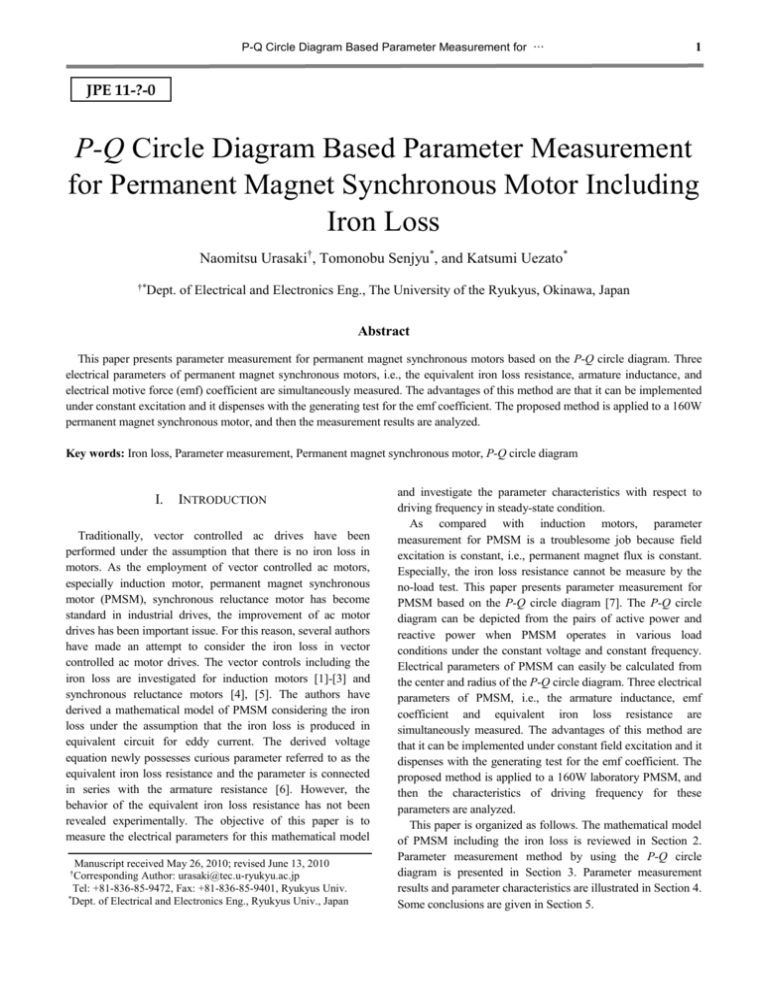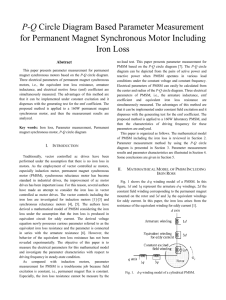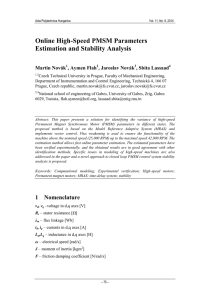PQ Circle Diagram Based Parameter Measurement for Permanent
advertisement

P-Q Circle Diagram Based Parameter Measurement for … 1 JPE 11-?-0 P-Q Circle Diagram Based Parameter Measurement for Permanent Magnet Synchronous Motor Including Iron Loss Naomitsu Urasaki†, Tomonobu Senjyu*, and Katsumi Uezato* †* Dept. of Electrical and Electronics Eng., The University of the Ryukyus, Okinawa, Japan Abstract This paper presents parameter measurement for permanent magnet synchronous motors based on the P-Q circle diagram. Three electrical parameters of permanent magnet synchronous motors, i.e., the equivalent iron loss resistance, armature inductance, and electrical motive force (emf) coefficient are simultaneously measured. The advantages of this method are that it can be implemented under constant excitation and it dispenses with the generating test for the emf coefficient. The proposed method is applied to a 160W permanent magnet synchronous motor, and then the measurement results are analyzed. Key words: Iron loss, Parameter measurement, Permanent magnet synchronous motor, P-Q circle diagram I. INTRODUCTION Traditionally, vector controlled ac drives have been performed under the assumption that there is no iron loss in motors. As the employment of vector controlled ac motors, especially induction motor, permanent magnet synchronous motor (PMSM), synchronous reluctance motor has become standard in industrial drives, the improvement of ac motor drives has been important issue. For this reason, several authors have made an attempt to consider the iron loss in vector controlled ac motor drives. The vector controls including the iron loss are investigated for induction motors [1]-[3] and synchronous reluctance motors [4], [5]. The authors have derived a mathematical model of PMSM considering the iron loss under the assumption that the iron loss is produced in equivalent circuit for eddy current. The derived voltage equation newly possesses curious parameter referred to as the equivalent iron loss resistance and the parameter is connected in series with the armature resistance [6]. However, the behavior of the equivalent iron loss resistance has not been revealed experimentally. The objective of this paper is to measure the electrical parameters for this mathematical model Manuscript received May 26, 2010; revised June 13, 2010 Corresponding Author: urasaki@tec.u-ryukyu.ac.jp Tel: +81-836-85-9472, Fax: +81-836-85-9401, Ryukyus Univ. * Dept. of Electrical and Electronics Eng., Ryukyus Univ., Japan † and investigate the parameter characteristics with respect to driving frequency in steady-state condition. As compared with induction motors, parameter measurement for PMSM is a troublesome job because field excitation is constant, i.e., permanent magnet flux is constant. Especially, the iron loss resistance cannot be measure by the no-load test. This paper presents parameter measurement for PMSM based on the P-Q circle diagram [7]. The P-Q circle diagram can be depicted from the pairs of active power and reactive power when PMSM operates in various load conditions under the constant voltage and constant frequency. Electrical parameters of PMSM can easily be calculated from the center and radius of the P-Q circle diagram. Three electrical parameters of PMSM, i.e., the armature inductance, emf coefficient and equivalent iron loss resistance are simultaneously measured. The advantages of this method are that it can be implemented under constant field excitation and it dispenses with the generating test for the emf coefficient. The proposed method is applied to a 160W laboratory PMSM, and then the characteristics of driving frequency for these parameters are analyzed. This paper is organized as follows. The mathematical model of PMSM including the iron loss is reviewed in Section 2. Parameter measurement method by using the P-Q circle diagram is presented in Section 3. Parameter measurement results and parameter characteristics are illustrated in Section 4. Some conclusions are given in Section 5. 2 Journal of Power Electronics, Vol. 11, No. ?, Month 2011 II. MATHMATHICAL MODEL OF PMSM INCLUDING IRON ROSS Fig. 1 shows the d-q winding model of a PMSM. In this figure, 1d and 1q represent the armature d-q windings, 2d the constant field winding corresponding to the permanent magnet mounted on the rotor and 3d and 3q the equivalent windings for eddy current. In this paper, the iron loss arises from the resistance of the equivalent winding for eddy current [1]. From the d-q winding model, the voltage equation for each winding in steady-state condition is expressed as [6]. V1d R1 V 1q r L 0 0 0 r L3 r L1 0 R1 r M13 r M13 R3 0 r L3 r M13 I1d 0 I1q r L3 I 3d R3 I 3q 0 M r 12 I 2 d 0 M 32 I3q I 2d ) (r2 M13L3I1d r M13R3I1q r2 L3M 32 ( R32 r2 L23 ) I 2d ) (r2 M13L3I1q r M13R3I1d r R3M 32 ( R32 r2 L23 ) 2M L r M13 R3 , M 32 q r 13 3 M 32 M 32 R32 r2 L23 R32 r2 L23 The parameter Rm is referred to as the equivalent iron loss resistance and is connected in series with the armature resistance R1. L1 denotes the armature inductance. Assuming that the mutual inductances M32d and M32q are sufficiently small as compared with the mutual inductance M12, these inductances are neglected; as a result, the voltage equation is simplified as, V1d R1 Rm V 1q r L1 (1) where, V1 and I1 denote the armature voltage and current, respectively. I2 and I3 denote the equivalent field current and equivalent eddy current, respectively. ωr is the electrical angular velocity. R and L denote the each winding resistance and self-inductance, respectively, M is the mutual inductance between windings, and each subscript expresses each winding. Equation (1) is the form that the equivalent eddy currents remain. Since the equivalent eddy currents cannot directly be detected, the equivalent eddy currents should be eliminated by succeeding manipulations. From (1), the equivalent eddy currents are straightforwardly derived as follows: I3d M 32d (2) r L1 I1d 0 r R1 Rm I1q Ke where, Ke (= M12I2d) represents the emf coefficient. The validity of this simplification is confirmed by the experimental result illustrated in Section 4. III. PARAMETER MEASUREMENT BY P-Q CIRCLE DIAGRAM The electrical parameters of PMSM are measured based on the P-Q circle diagram. In this method, external load is gradually applied to PMSM under terminal voltage with constant amplitude and constant frequency. The input active and reactive powers for each load are measured at that time. Then, the P-Q circle diagram is depicted from the pairs of active and reactive powers. Three electrical parameters including the equivalent iron loss resistance Rm are calculated from the center and radius of the P-Q circle diagram. The following illustrates the relationship between the P-Q circle diagram and the electrical parameters. Fig. 2 shows the vector diagram for PMSM in steady-state condition. In this figure, V and I denote voltage vector and current vector, respectively. (3) Substituting (2) and (3) in (1), the order of the voltage equation can be reduced as, V1d R1 Rm V 1q r L1 M 32 d r L1 I1d r M M I 2 d (4) R1 Rm I1q 32 q 12 where, Rm 2 r2 M13 2M 2 R , L1 L1 2 r 13 L3 2 2 2 3 R3 r L3 R3 r2 L23 (5) Fig. 1. d-q winding model of a cylindrical PMSM. P-Q Circle Diagram Based Parameter Measurement for… The input active power P and reactive power Q are expressed as, P VI cos where, V V12d calculated by using the center of the P-Q circle diagram depicted on each driving frequency. (6) (7) Q VI sin V12q , I I12d I12q and φ is the power factor angle. IV. MEASUREMENT RESULTS In this section, parameter measurement results based on the P-Q circle diagram are presented and their characteristics with respect to driving frequency are also illustrated. The specifications of the PMSM utilizing in this research are listed in Table I. Fig. 4 shows the experimental system to execute parameter measurement based on the P-Q circle diagram. In order to measure the electrical parameters on various driving frequencies, a PWM inverter with 7.5 kHz carrier frequency is utilized. A digital power meter detects (DPM) the active power, reactive power, and input voltage. Load conditions for the PMSM is adjusted by changing the external resistance through the generator (PMSG) that connects directly to the PMSM. 3 V. CONCLUSIONS This paper proposes parameter measurement for PMSM including iron loss. In the proposed method, three electrical parameters of PMSM, i.e., the equivalent iron loss resistance, armature resistance and emf coefficient are simultaneously measured based on P-Q circle diagram. This method can be applied to motor with constant field excitation machines such as PMSM. In addition, it dispenses with the generating test for the emf coefficient. The proposed method is applied to a 160W permanent magnet synchronous motor, and then the measurement results are analyzed. The equivalent iron loss resistance increases with increasing driving frequency while the armature inductance and emf coefficient are almost constant. The validity of this proposed method is confirmed by the comparison with the traditional method. APPENDIX Motor data: Ra = 2.8 Ώ, TABLE I ACKNOWLEDGMENT MOTOR SPECIFICATIONS This work was supported by … Rated power Rated torque Rated speed Number of pole-pairs 160 W 0.5N·m 3000 rpm 2 A. Equivalent iron loss resistance The parameter measurement results for the equivalent iron loss resistance Rm, which is introduced newly in voltage equation of PMSM, is discussed in this subsection. The measurement is executed in wide frequency range from 40Hz to 100Hz under various V/f ratios. As discussed in Section 3, the equivalent iron loss resistance is calculated by using the center of the P-Q circle diagram depicted on each driving frequency. Fig. 6 shows the equivalent iron loss resistance versus driving frequency. As can be seen from this figure, the equivalent iron loss resistance increases with increasing driving frequency. In order to explain this reason, two assumptions are introduced: B. Armature inductance The parameter measurement for the armature inductance L1 is also executed in wide frequency range from 40Hz to 100Hz under various V/f ratios. The armature inductance is REFERENCES [1] [2] [3] [4] [5] N. H. Kim, “Rotor fault detection system for inverter driven induction motor using current signals and an Encoder,” Journal of Power Electronics, Vol. 7, No. 4, pp. 271-277, Oct. 2007. F. A. Huliehel, F. C. Lee, and B. H. Cho, “Small-signal modeling of the single-phase boost high power factor converter with constant frequency control,” in Proc. PESC, pp. 475-482, 1992. T. J. E. Miller, Reactive Power Control in Electric Systems, John Willey&Sons, chap. 2, 1982. Myway labs -PSIM- http://www.myway-labs.co.jp/psim, May 13th 2009. S. K. Dwivedi, "Power Quality Improvements and Sensor Reductions in Permanent Magnet Synchronous Drives," PhD. Thesis, IIT Delhi, 2006. Naomitsu Urasaki was born in Okinawa Prefecture, Japan in 1973. He received the B.S. and M.S. degrees in electrical engineering from University of the Ryukyus, Japan, in 1996 and 1998, respectively. Since 1998, he has been with Department of Electrical and Electronics Engineering, Faculty of Engineering, University of the Ryukyus, where he is currently a Research Associate. His 4 Journal of Power Electronics, Vol. 11, No. ?, Month 2011 research interests are in the areas of modeling and control of ac motors. Mr. Urasaki is a Member of the Institute of Electrical Engineers of Japan. Tomonobu Senjyu was born in Saga Prefecture, Japan, in 1963. He received the B.S. and M.S. degrees in electrical engineering from the University of the Ryukyus, Okinawa, Japan, in 1986 and 1988, respectively, and the Ph.D. degree in electrical engineering from Nagoya University, Nagoya, Japan, in 1944. Since 1988, he has been with the Department of Electrical and Electronics Engineering, Faculty of Engineering, University of the Ryukyus, where he is currently a professor. His research interests are in the areas of stability of ac machines, advanced control of electrical machines, and power electronics. Prof. Senjyu is a member of the Institute of Electrical Engineers of Japan. Katsumi Uezato was born in Okinawa Prefecture, Japan, in 1940. He received the B.S. degrees in electrical engineering from the University of the Ryukyus, Okinawa, Japan, in 1963, the M.S. degree in electrical engineering from Kagoshima University, Kagoshima, Japan, in 1983. Since 1972, he has been with the Department of Electrical and Electronics Engineering, Faculty of Engineering, University of the Ryukyus, where he is currently a Professor. He is engaged in research on stability and control of synchronous machines. Prof. Uezato is a member of the Institute of Electrical Engineers of Japan.









